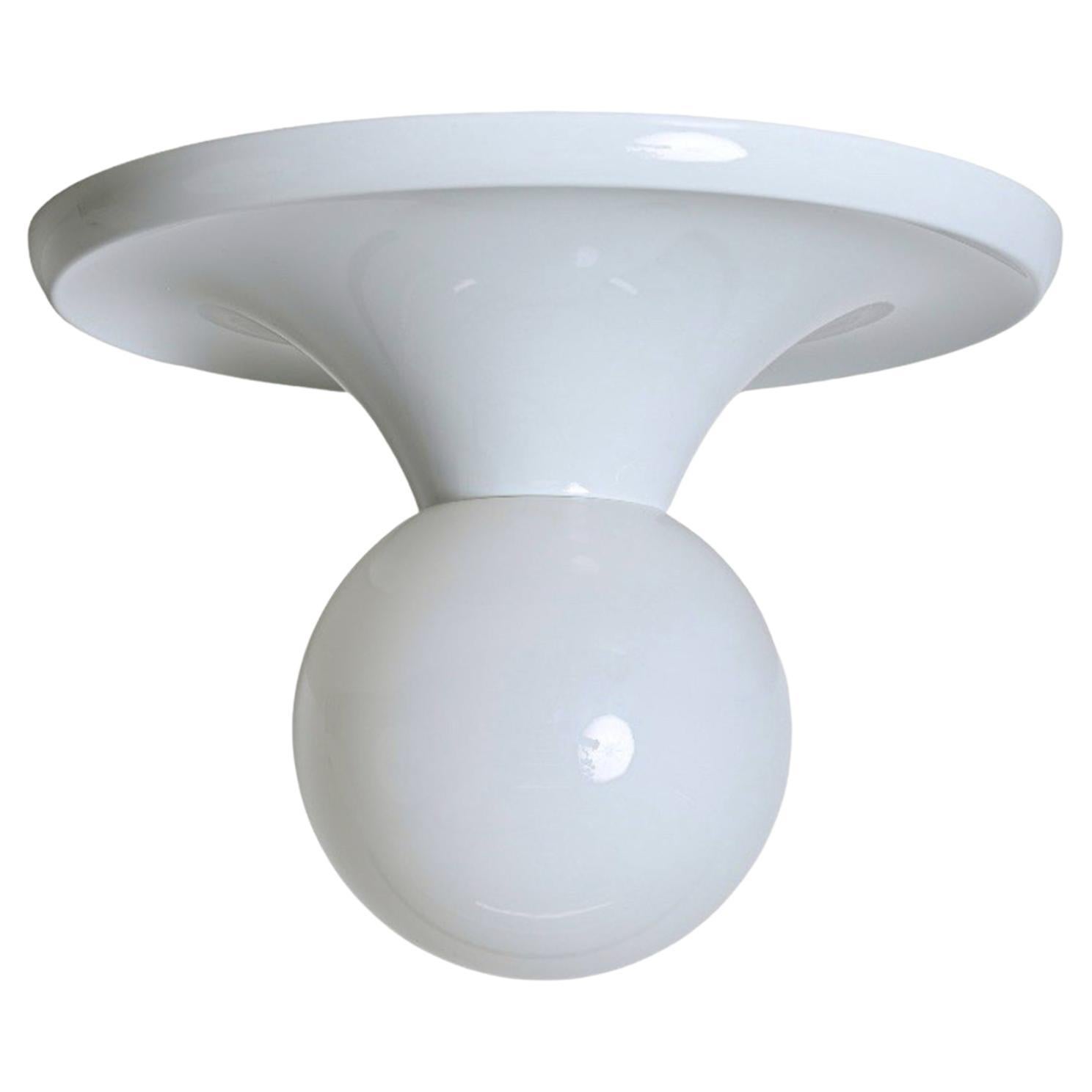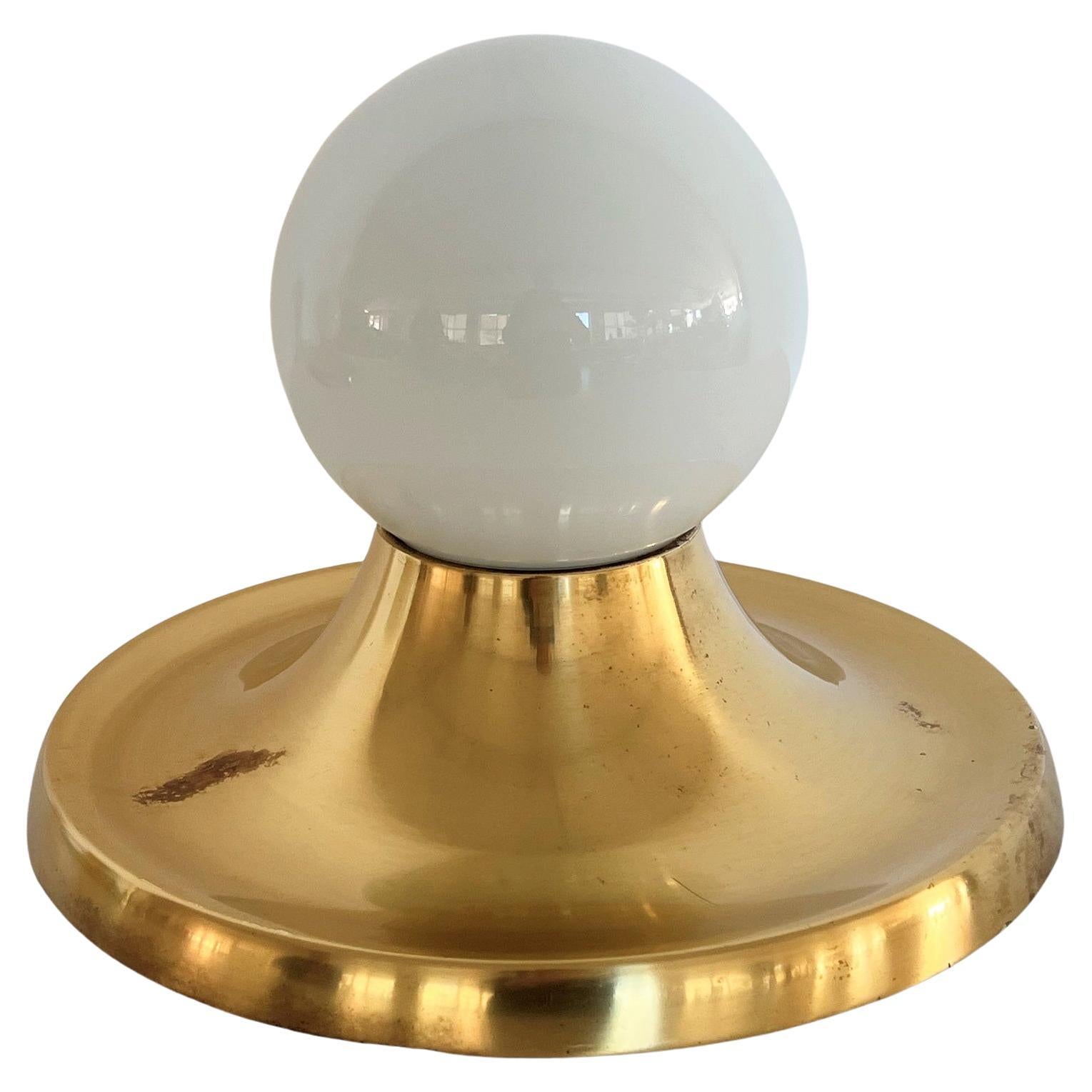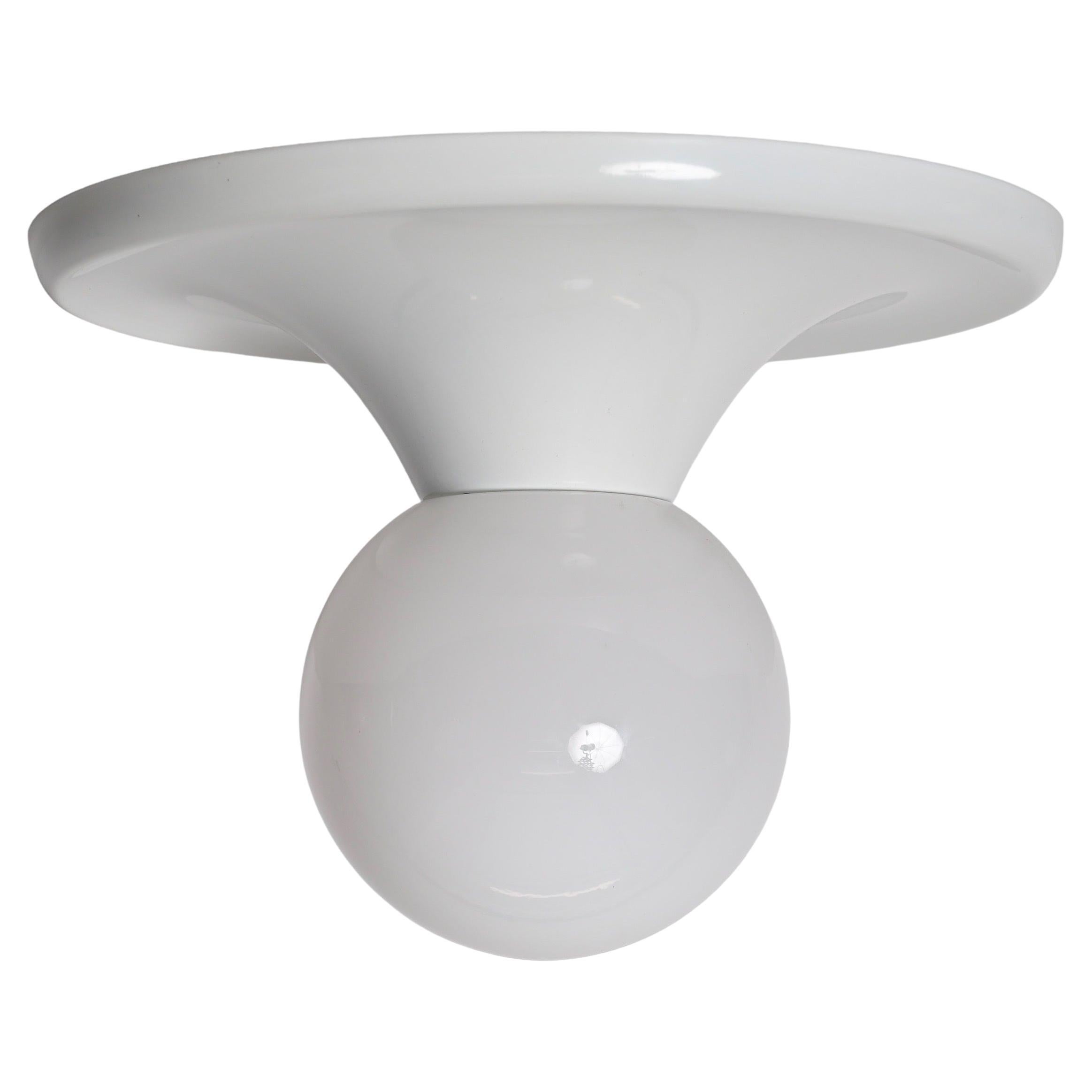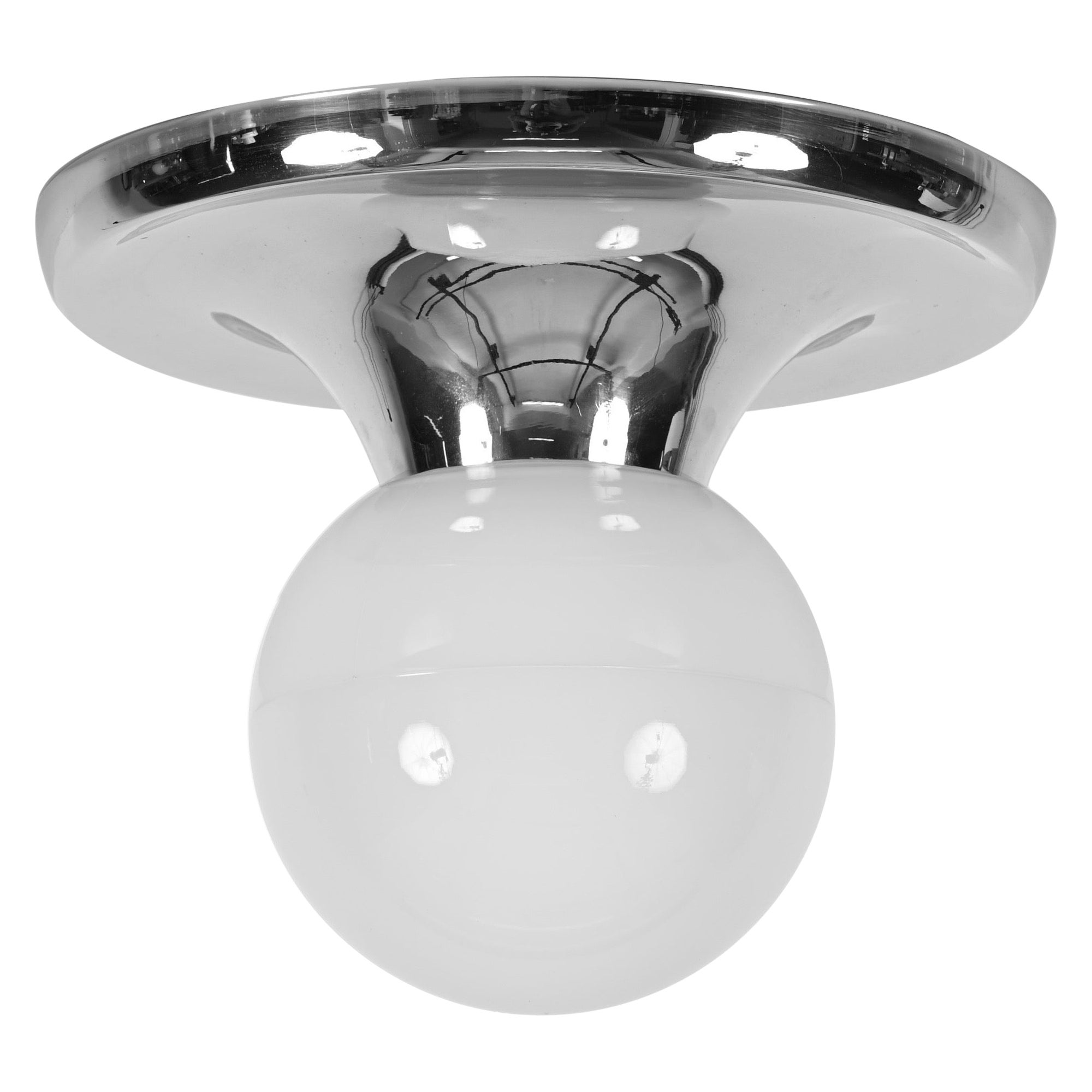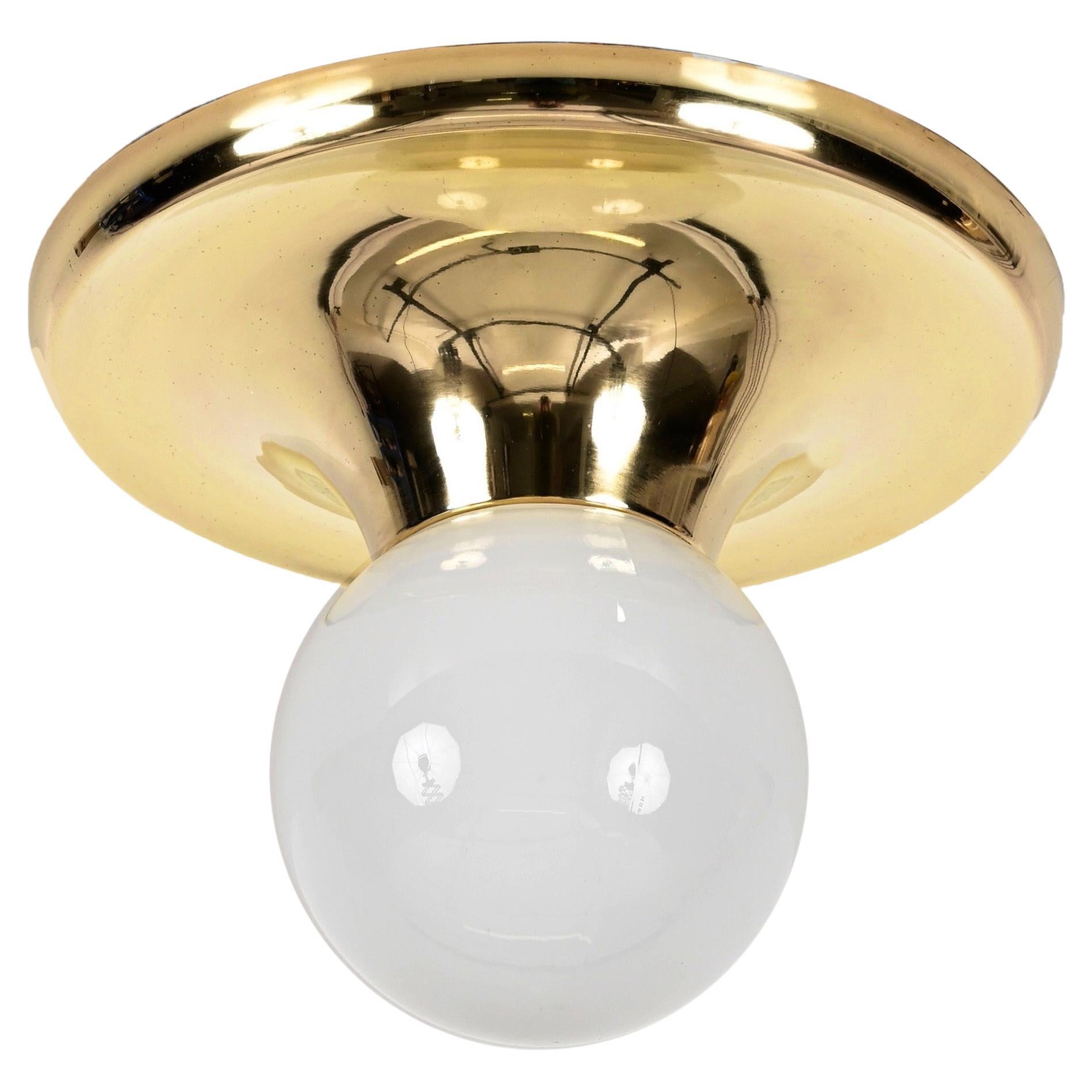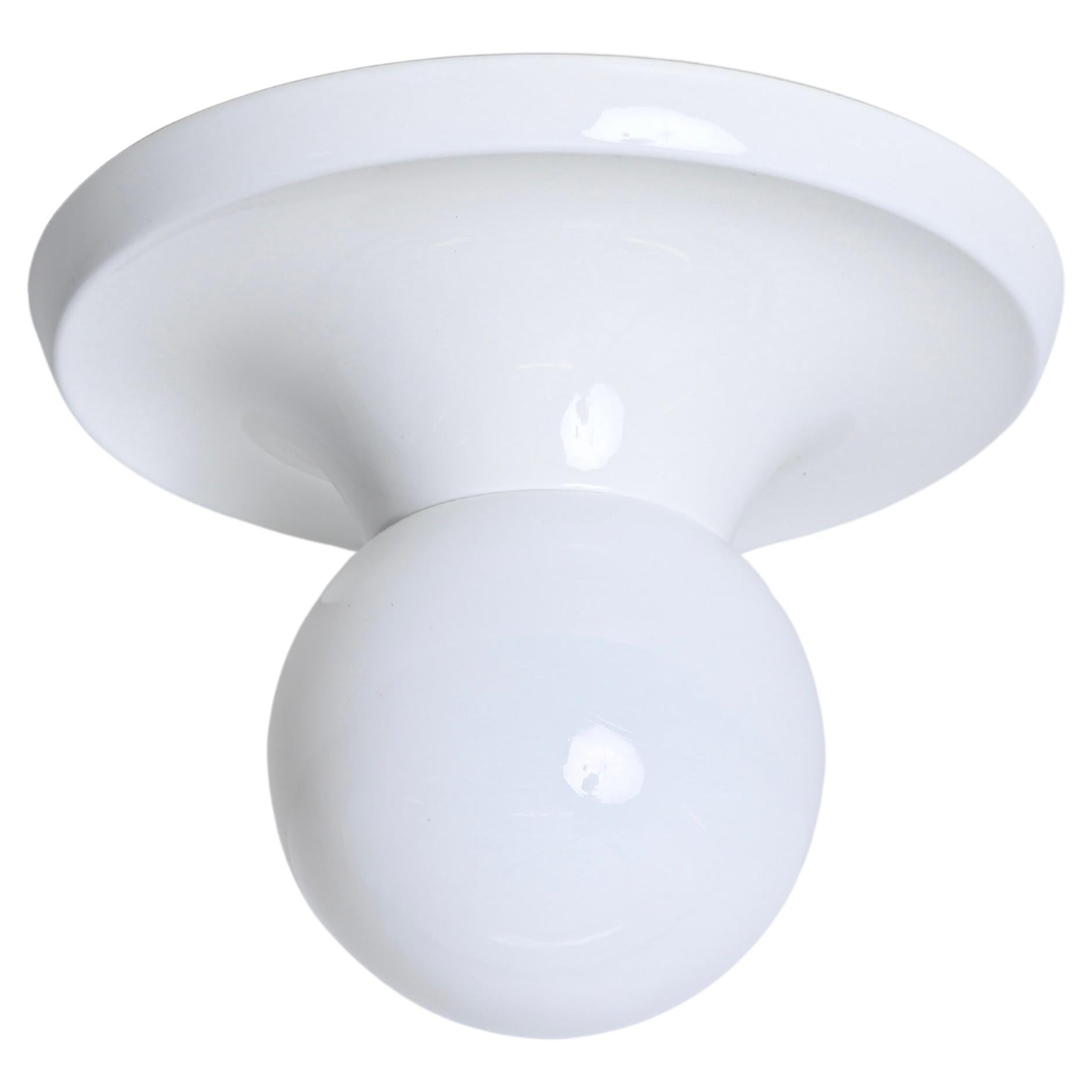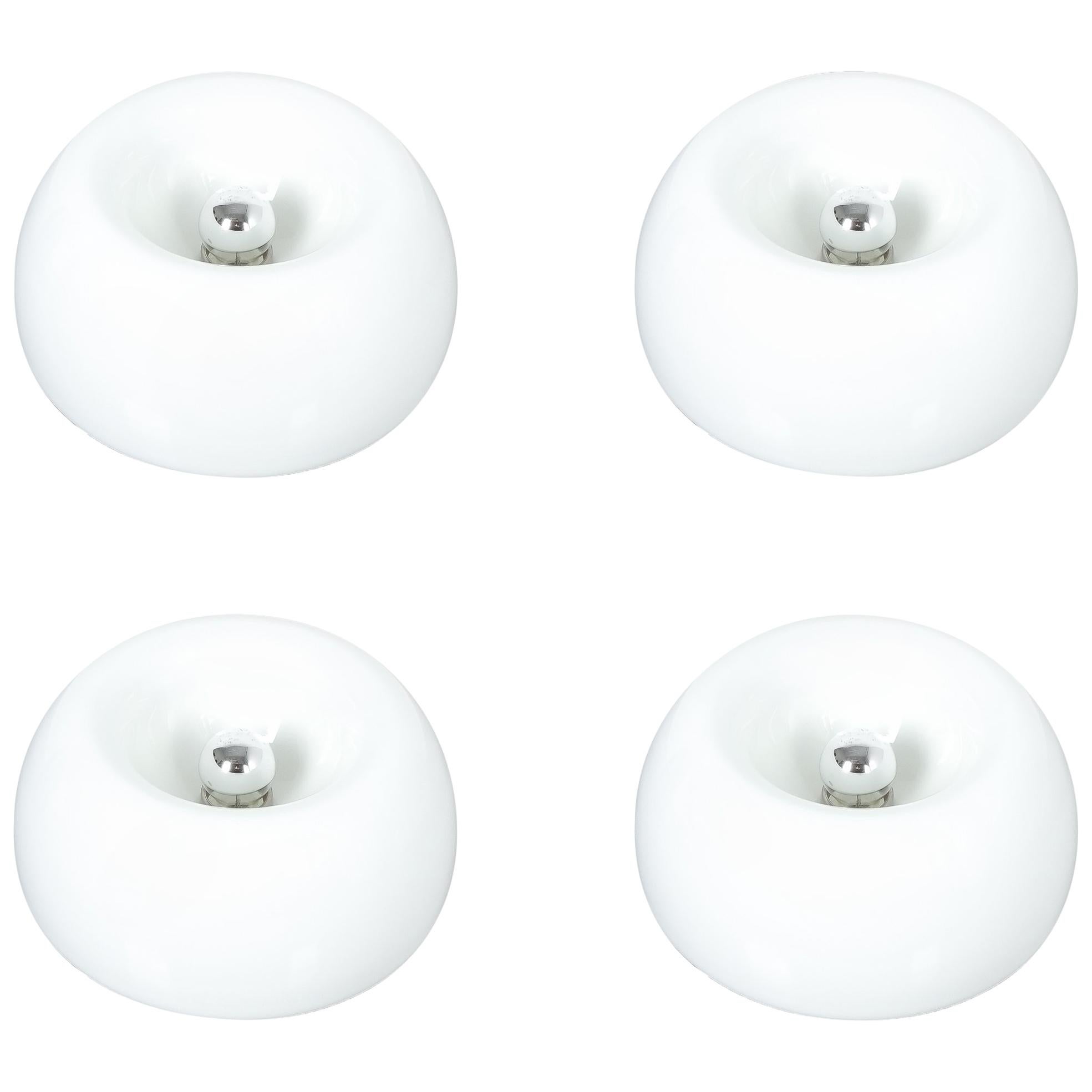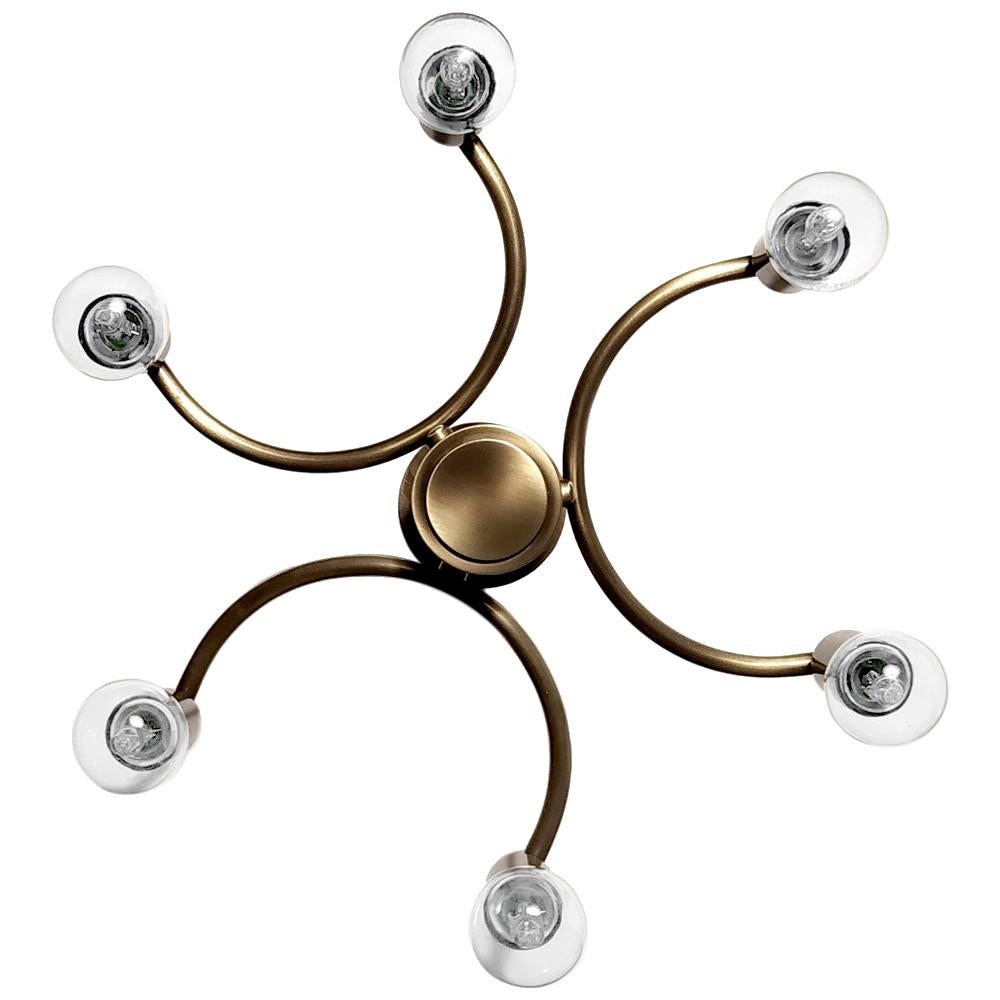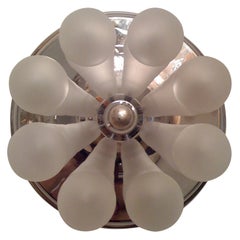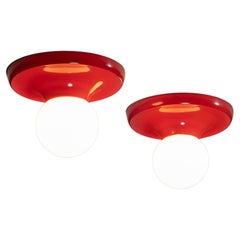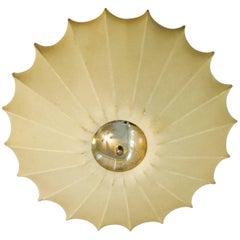
Castiglioni Italian Midcentury 1960s Sculptural Ceiling Wall Light
View Similar Items
Castiglioni Italian Midcentury 1960s Sculptural Ceiling Wall Light
About the Item
- Creator:Flos (Maker),Achille Castiglioni (Designer)
- Dimensions:Height: 5 in (12.7 cm)Diameter: 18 in (45.72 cm)
- Style:Mid-Century Modern (Of the Period)
- Materials and Techniques:
- Place of Origin:
- Period:
- Date of Manufacture:1960
- Condition:Wear consistent with age and use.
- Seller Location:New York, NY
- Reference Number:1stDibs: LU78678212183
Flos
Imaginative lighting is a longtime hallmark of modern Italian design. Following in the footsteps of innovative companies such as Artemide and Arteluce, the company FLOS brought a fresh aesthetic philosophy to the Italian lighting field in the 1960s, one that would produce several of the iconic floor lamp, table lamp and pendant light designs of the era.
FLOS — Latin for “flower” — was founded in the northern town of Merano in 1962 by Cesare Cassina (of the famed Cassina furniture-making family) and Dino Gavina, a highly cultured businessman who believed that artistic ideas espoused in postwar Italy could inform commercial design. The two enlisted brothers Achille and Pier Giacomo Castiglioni as their first designers.
Even before FLOS was formally incorporated, the Castiglionis gave the firm one of its enduring successes with the Taraxacum pendant and associated designs made by spraying an elastic polymer on a metal armature. (George Nelson had pioneered the technique in the United States in the early 1950s.) For other designs, the brothers found inspiration in everyday objects. Suggestive of streetlights, their Arco floor lamp, with its chrome boom and ball-shaped shade sweeping out from a marble block base, has become a staple of modernist decors. Designing for FLOS since 1966, Tobia Scarpa has also been inspired by the commonplace. His folded-metal Foglio sconces resemble a shirt cuff; his carved marble Biagio table lamp looks like a jai alai basket.
In 1973, FLOS purchased Arteluce, the company founded in 1939 by Gino Sarfatti, and it continues to produce his designs. In recent decades, FLOS has contracted work from several noted designers, including Marcel Wanders and Jasper Morrison. As instantly recognizable as they are, many FLOS designs remain accessible. While FLOS lighting is the essence of modernity, its sleek, subtle designs can be used to strike a sculptural note in even traditional spaces.
Browse a broad range of FLOS lighting fixtures at 1stDibs.
- Limburg Sculptural Glass 1960s Flush LightBy Glashütte LimburgLocated in New York, NYA large bubbled glass flush light by Limburg Glass works. Newly rewired. Three-light sources. Matching 12” version available.Category
Vintage 1960s German Mid-Century Modern Flush Mount
MaterialsBlown Glass
- Nautical Italian Mid-Century 1960s Flush Ceiling LampLocated in New York, NYA 1960s nautical style golden brass ceiling fixture with a hallophane glass shade. Newly rewired.Category
Vintage 1960s Italian Mid-Century Modern Flush Mount
MaterialsBrass
- German, 1970s Wall Sconce or Ceiling LightBy KinkeldeyLocated in New York, NYA high style 1970s wall or flush ceiling light by the German maker, Kinkeldey. A curved circular chrome fixture holding eight frosted glass ball shades.Category
Vintage 1970s German Mid-Century Modern Flush Mount
MaterialsChrome
- Doria Space Age Flush Ceiling/Wall LightBy Doria Leuchten GermanyLocated in New York, NYA 1970s Space-Age German flush or wall sconce by the lighting company, Doria. Four light sources. Rewired.Category
Vintage 1970s German Mid-Century Modern Flush Mount
MaterialsPVC
- 1960s Space Age Modernist Flush LightBy Doria Leuchten GermanyLocated in New York, NYA great 1960s German copper mirrored glass and hold shade flush light. Rewired.Category
Vintage 1960s German Mid-Century Modern Flush Mount
MaterialsBrass
- Austrian 1960s Stejnar Crystal Flush LightBy Emil StejnarLocated in New York, NYA golden brass and clear and light amethyst color crystal flush ceiling or wall light by the Austrian lighting company, Stejnar. Newly Rewired. Two-light sources.Category
Vintage 1960s Austrian Mid-Century Modern Flush Mount
MaterialsCrystal, Brass
- White "Light Ball" by Flos, Italian Wall or Ceiling Lamp, Castiglioni 1960sBy Flos, Achille CastiglioniLocated in Roma, ITGorgeous white Light Ball, designed by Achille Castiglioni for Flos in Italy in the 1960s. in white metal and opal glass. This fantastic lamp was designed by Castiglioni for Arteluc...Category
Vintage 1960s Italian Mid-Century Modern Flush Mount
MaterialsMetal
- Italian Achille Castiglioni 'Light Ball' Wall or Ceiling Lamp for Flos, 1960sBy Flos, Achille CastiglioniLocated in Morazzone, VareseGorgeous large flush mount light, wall lamp or ceiling lamp called "Light Ball" designed in Italy from Achille Castiglioni for Flos. Designed in 1965, this vintage brass variant comes with satin opaque glass which is screwed into the lamp. Please check out all pictures. This iconic mid-century design is quintessentially Italian. Nice patina and gorgeous dark vintage on the brass, loved from all real vintage lovers...Category
Vintage 1960s Italian Mid-Century Modern Flush Mount
MaterialsBrass
- "Light Ball" Wall / Ceiling Lamps by Castiglioni for Flos, Italy, 1960sBy Flos, Achille & Pier Giacomo CastiglioniLocated in Milan, ITLight Ball model 2 by Achille and Pier Giacomo Castiglioni for Flos. Minimal wall / ceiling lamp providing diffused light. Base in enameled spun aluminum, opal glass sphere with sc...Category
Vintage 1960s Italian Flush Mount
MaterialsMetal
- Castiglioni Metal "Light Ball" Italian Sconce for Arteluce and Flos, 1960sBy Flos, Arteluce, Achille CastiglioniLocated in Roma, ITIncredibly rare first edition of the famous "Light Ball" applique by Castiglioni in white metal and opal glass. This fantastic lamp was designed by Castiglioni for Arteluce and produced in Italy by Flos in the 1960s. This fantastic lamp was designed by Castiglioni for Arteluce and produced in Italy by Flos in the 1960s. This fantastic light is unique because of the materials, made of white enameled metal and opal glass. It can be mounted on the wall or on the ceiling. The wall light has been tested, it uses an E27 light bulb. It is signed on the backplate by both Arteluce and Flos. A fantastic piece that will grace a mid-century living room or bathroom. Measures (cms): diameter - 42 height - 32 Literature: Casa Amica, 27 June 1972, p. 105 Octagon 30 September 1973, p. 149 Sergio Polano, Achille Castiglioni all the works, Electa, Milano, 2001, p. 224 Giuliana Gramigna, repertoire 1950-2000, Allemandi, Torino, 2003, p. 121. The beginnings of Flos (meaning “flower” in Latin) blossomed from a brilliant idea: to create objects, starting with a light bulb, that would change the way of life for both the Italian market and the foreign markets. Dino Gavina and the small Eisenkeil manufacturing facility in Merano, had already been creating furniture alongside design masters such as Achille and Pier Giacomo Castiglioni, Afra and Tobia Scarpa. But by the early 1960s, Gavina became convinced the time had come to create new lamps. Using the same technology – conceived in the USA and tested at Eisenkeil – used for the Cocoon lampthe Castiglioni brothers and the Scarpa duo began creating lamps such as the Taraxacum or the Fantasma, with many other beautiful and surprising lamps to follow. And so, from day one, Flos was already reinventing the idea of artificial lighting. Achille Castiglioni (born February 16, 1918, Milan–died December 2, 2002, Milan) was a prolific furniture, lighting, and product Italian designer renown for his ironic, joyful, creative and functional designs that, at times, intersected with ideas explored by conceptual artists. Achille Castiglioni was born into a family with deep appreciation for the arts, as he was the third son of sculptor and coin engraver Giannino Castiglioni and his wife Livia Bolla. He first studied the classics at the Liceo Classico Giuseppe Parini, but then switched to study art at the Accademia di Belle Arti di Brera in Milan. In 1937, he decided to follow the steps of his two elder brothers, architects Livio and Pier Giacomo Castiglioni, by enrolling in the Faculty of Architecture at the Politecnico di Milano, graduating in 1944–after having to interrupt his studies when he was stationed in Greece and Sicily during World War II. In 1944, immediately after graduating, Achille Castiglioni joined his brothers Livio and Pier Giacomo in the design studio that they had founded with Livio’s classmate Luigi Caccia Dominioni in 1937 in Milan. Fortunately for Achille, from the very beginning Livio and Pier Giacomo decided to focus almost entirely on designing exhibitions, furniture, housewares, and appliances since architectural commissions were difficult to come by during the war. This product-design focus, and the deep fraternal bound among the three brothers, would later allow the young Achille to experiment early in his career with emerging techniques and new materials that could communicate a fresh aesthetic sensibility suited for the positive outlook of the post-war European market. The Castiglioni brothers’ important collaboration with Phonola and Brionvega In 1940, Pier Giacomo Castiglioni, Livio Castiglioni, and Luigi Caccia Dominioni, in collaboration withe the Phonola company, presented in the VII Triennale di Milano (Milan Triennial), titled Exhibition of the Radio, a research study of radio devices that included the Fimi Phonola 547 radio, the first radio encased in Bakelite instead of wood. Shortly after the exhibition, Luigi Caccia Dominioni suspended his professional activity to serve in the military during World War II and left the studio. The development of the FImi Phonola 547 radio would prove fruitful for the three brothers, as it allowed Livio Castiglioni to cement his role as the leading design consultant for Phonola from 1940 until 1960, and for Brionvega, from 1960 until 1964. These relationships brought in further collaboration among the three brothers, and would eventually result in several designs for radio and sound appliances with innovative materials and shapes for which Achille Castiglioni played a key role, such as the RR 226 stereo system for Brinovega (1965), the radio phonograph RR 126 for Brinovega (1965), and the radio and record player RR 128 for Brionvega (1966) In 1952, Livio decided to build his own practice, independent from Achille and Pier Giacomo, to pursue a deeper exploration of radio waves, music, and technology. But the three brothers would continued to collaborate closely in several projects, and the partnership between Achille and Pier Giacomo became so tight that from 1952 until 1968, when Pier Giacomo died, they co-authored most of their designs. Achille Castiglioni Long Career as Light Designer During this period, the Castiglioni brothers participated in the Italian Exhibition of Furniture (RIMA), where they successfully introduced a series of curved-plywood furniture, and presented important designs, such as the Tubino lamp (1949), originally produced by Italian light maker Arteluce from 1949 until 1974, and reintroduced by FLOS since the late 1970s; and the Luminator lamp (1955), originally produced by Gilardi & Barzaghi, but reintroduced by FLOS in the late 1960s. A new, successful, and long-lasting collaboration developed in 1960, when Pier Giacomo and Achille Castiglioni were reached by entrepreneurial Italian designer Dino Gavina and business man Arturo Eisenkeil with the idea to create a completely new kind of lighting fixtures utilizing a polyamide. The material, which they called “cocoon,” in the hands of the Castiglioni brothers would become a popular and iconic innovation in the 1960s and serve as the successful foundation of Italian lighting company FLOS–founded by Gavina and Eisenkeil in 1962. Pier Giacomo and Achille Castiglioni designed a series of “cocoon” lights utilizing the spray-on polyamide plastic as a coating layer onto a metal frame. Among the most popular Castiglioni “cocoon” lights are: the Taraxacum and the Viscontea ceiling lamps (1960), and the Gatto table lamp (1961). Other of the important lamp designs by Pier Giacomo and Achille Castiglioni for FLOS are the Beehive -or Splügen Braü lamp (1961), Toio –or Toy lamp...Category
Vintage 1960s Italian Mid-Century Modern Flush Mount
MaterialsMetal
- Castiglioni Midcentury Metal "Light Ball" Italian Sconce for Flos, 1960sBy Flos, Achille & Pier Giacomo CastiglioniLocated in Roma, ITIncredible mid-century "Light Ball large size" applique in smatised ivory metal and opal glass for Flos. This fantastic lamp was designed by Achille Castiglioni and produced in Italy for Flos in the 1960s. This fantastic light is unique because of the materials, made of ivory white enameled metal and opal glass. Requires an E27 bulb. A fantastic piece that will grace a mid-century living room or bathroom. Measures (cms): diameter - 42 height - 31 Literature: Casa Amica, 27 June 1972, p. 105 Octagon 30 September 1973, p. 149 Sergio Polano, Achille Castiglioni all the works, Electa, Milano, 2001, p. 224 Giuliana Gramigna, repertoire 1950-2000, Allemandi, Torino, 2003, p. 121. The beginnings of Flos (meaning “flower” in Latin) blossomed from a brilliant idea: to create objects, starting with a light bulb, that would change the way of life for both the Italian market and the foreign markets. Dino Gavina and the small Eisenkeil manufacturing facility in Merano, had already been creating furniture alongside design masters such as Achille and Pier Giacomo Castiglioni, Afra and Tobia Scarpa. But by the early 1960s, Gavina became convinced the time had come to create new lamps. Using the same technology – conceived in the USA and tested at Eisenkeil – used for the Cocoon lampthe Castiglioni brothers and the Scarpa duo began creating lamps such as the Taraxacum or the Fantasma, with many other beautiful and surprising lamps to follow. And so, from day one, Flos was already reinventing the idea of artificial lighting. Achille Castiglioni (born February 16, 1918, Milan–died December 2, 2002, Milan) was a prolific furniture, lighting, and product Italian designer renown for his ironic, joyful, creative and functional designs that, at times, intersected with ideas explored by conceptual artists. Achille Castiglioni was born into a family with deep appreciation for the arts, as he was the third son of sculptor and coin engraver Giannino Castiglioni and his wife Livia Bolla. He first studied the classics at the Liceo Classico Giuseppe Parini, but then switched to study art at the Accademia di Belle Arti di Brera in Milan. In 1937, he decided to follow the steps of his two elder brothers, architects Livio and Pier Giacomo Castiglioni, by enrolling in the Faculty of Architecture at the Politecnico di Milano, graduating in 1944–after having to interrupt his studies when he was stationed in Greece and Sicily during World War II. In 1944, immediately after graduating, Achille Castiglioni joined his brothers Livio and Pier Giacomo in the design studio that they had founded with Livio’s classmate Luigi Caccia Dominioni in 1937 in Milan. Fortunately for Achille, from the very beginning Livio and Pier Giacomo decided to focus almost entirely on designing exhibitions, furniture, housewares, and appliances since architectural commissions were difficult to come by during the war. This product-design focus, and the deep fraternal bound among the three brothers, would later allow the young Achille to experiment early in his career with emerging techniques and new materials that could communicate a fresh aesthetic sensibility suited for the positive outlook of the post-war European market. The Castiglioni brothers’ important collaboration with Phonola and Brionvega In 1940, Pier Giacomo Castiglioni, Livio Castiglioni, and Luigi Caccia Dominioni, in collaboration withe the Phonola company, presented in the VII Triennale di Milano (Milan Triennial), titled Exhibition of the Radio, a research study of radio devices that included the Fimi Phonola 547 radio, the first radio encased in Bakelite instead of wood. Shortly after the exhibition, Luigi Caccia Dominioni suspended his professional activity to serve in the military during World War II and left the studio. The development of the FImi Phonola 547 radio would prove fruitful for the three brothers, as it allowed Livio Castiglioni to cement his role as the leading design consultant for Phonola from 1940 until 1960, and for Brionvega, from 1960 until 1964. These relationships brought in further collaboration among the three brothers, and would eventually result in several designs for radio and sound appliances with innovative materials and shapes for which Achille Castiglioni played a key role, such as the RR 226 stereo system for Brinovega (1965), the radio phonograph...Category
Vintage 1960s Italian Mid-Century Modern Flush Mount
MaterialsMetal
- Castiglioni Style Italian Wall Ceiling Light Flush Mount Aluminum Black, 1960sBy Achille Castiglioni, FlosLocated in Nierstein am Rhein, DERare Italian ceiling flush mount or wall light with attribution to Achille and Pier Giacomo Castiglioni, Italy around 1960s to 1970s. The cool space-age lamp is made of stronger brus...Category
Vintage 1960s Italian Space Age Flush Mount
MaterialsAluminum
